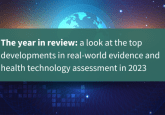FDA adds real-world evidence to list of approved confirmatory evidence in new draft guidance

The FDA draft guidance, called ‘Demonstrating Substantial Evidence of Effectiveness Based on One Adequate and Well-Controlled Clinical Investigation and Confirmatory Evidence,’ demonstrates the agency’s commitment to exploring new types of evidence as innovative therapies evolve.
On September 18, 2023, the US FDA announced a new draft guidance, to be called the Confirmatory Evidence guidance, clarifying the types of confirmatory evidence sponsors can use when demonstrating drug effectiveness through one adequate and well-controlled clinical investigation. The guidance is intended to provide more clarity and flexibility for sponsors and builds on previous draft guidance for industry issued in the 1998 Effectiveness guidance and 2019 Effectiveness draft guidance that outline the FDA’s standards for demonstrating effectiveness. Whilst the FDA’s ‘evidentiary standard for effectiveness’ has not changed, they recognize that a flexible approach is needed in clinical development; for instance, through various trial designs, trial endpoints, and statistical methodologies. The 2019 Effectiveness draft guidance briefly touched on substantial evidence standard needed from one adequate and well-controlled clinical investigation plus confirmatory evidence, and the Confirmatory Evidence guidance is intended to provide further detail on these requirements.
The FDA note that the use of one adequate and well-controlled clinical investigation to demonstrate substantial evidence of effectiveness is ‘determined case-by-case, for each application, in the context of the application as a whole.’ Sponsors need to provide ‘strong scientific rationale to support the use of a single clinical investigation and confirmatory evidence for their specific drug development program.’ To ensure that the evidentiary needs of the agency are met, the guidance stresses the importance of talking to the agency early in development ‘to evaluate whether a development program consisting of a single adequate and well-controlled clinical investigation and confirmatory evidence could demonstrate substantial evidence of effectiveness.’
The FDA highlights seven types of acceptable confirmatory evidence, including:
- Clinical evidence from a related indication
Where evidence of effectiveness has been established for a particular indication and can be used to provide confirmatory evidence in a different but closely related indication, such as in the case of arthritis and psoriatic arthritis, which have similarities in their underlying pathophysiology. - Mechanistic or pharmacodynamics evidence
If the pathophysiology of the disease and drug’s mechanism of action are clearly understood, mechanistic evidence of the drug’s treatment effect in a particular disease may be appropriate to use as confirmatory evidence. - Evidence from a relevant animal model
Occasionally, sponsors can use data from an established animal model of disease as confirmatory evidence of effectiveness. This depends on several factors, including similarity of pathophysiology and manifestations of the disease in the animal model and in humans, such as with antimicrobial drugs. - Evidence from other members of the same pharmacologic class
Considerations for this type of confirmatory evidence take into account the mechanism of action of the new drug, use of similar endpoints and number of drugs already approved in the class. - Evidence from natural history
Natural history studies are being increasingly used as the basis for confirmatory evidence in rare diseases. As the guidance notes, ‘such an approach can be useful when there is uncertainty about whether the outcomes observed in the control group accurately reflect those that would have been expected in the absence of the intervention.’ - Real-world data/evidence
The FDA has an established program focused on the use of real-world data (RWD) and real-world evidence (RWD) in regulatory decision making. RWD collected from a variety of sources, such as electronic health records, medical claims data and registries, can be used as confirmatory evidence, provided that the RWD source is reliable, relevant and uses appropriate prespecified statistical methods and analyses. - Evidence from expanded use of an investigational drug
The FDA notes that confirmatory evidence from expanded access to investigational drugs should only be considered ‘if the patient outcome information collected under expanded access use of the drug is of sufficient quantity and quality to be highly persuasive.’
Before the FDA finalizes the guidance, it is seeking feedback via the Federal Register, with comments due by December 18, 2023.
Want regular updates on the latest real-world evidence news straight to your inbox? Become a member on The Evidence Base® today>>>






